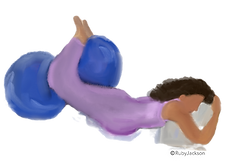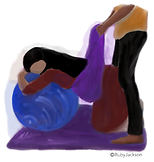About the Research
We’re interviewing midwives, doctors, and people who have given birth who have used or experienced biodynamic techniques during active (first and second) stages of labour.
Insights from these interviews will help design a clinical trial to test four promising techniques on a labour ward / obstetric unit. Our long-term goal is to establish which, if any, of these techniques are effective at safely supporting vaginal birth, and other impacts they may have on clinicians and birthing people.
What are biodynamic techniques and why are we doing this research?
Each year in the NHS 20,000 unplanned c-sections occur during the pushing stage of labour.(1) These late stage c-sections carry increased risks of severe bleeding, internal trauma, and psychological distress.(2,3) They also increase the risk of preterm birth in future pregnancies.(4)
Sometimes these c-sections happen because a baby is misaligned in some way, making it difficult for women and birthing people to push baby out.(5) We're exploring whether these targeted positional techniques can help optimise the physiology of the pelvis to facilitate a baby's rotation through the pelvis and birth canal during the active stages of labour, potentially increasing the chances of a safe vaginal birth.
(2) Pergialiotis, V. et al. First versus second stage C/S maternal and neonatal morbidity: A systematic review and meta-analysis. European Journal of Obstetrics and Gynecology and Reproductive Biology 175, 15–24 (2014)
(3) Olde, E., Van Der Hart, O., Kleber, R. & Van Son, M. Posttraumatic stress following childbirth: A review. Clin Psychol Rev 26, 1–16 (2006).
(4) Petrou, S., Kim, S. W., McParland, P. & Boyle, E. M. Mode of Delivery and Long-Term Health-Related Quality-of-Life Outcomes: A Prospective Population-Based Study. Birth 44, 110–119 (2017).
(5) Phipps, H. et al. Is there an association between sonographically determined occipito-transverse position in the second stage of labor and operative delivery? Acta Obstet Gynecol Scand 93, 1018–1024 (2014).
How will the interviews be used?
We hope to identify four promising techniques from the interviews. We will then take these techniques to a focus group of physiotherapists who specialise in pelvic health to discuss the potential benefits, risks, and mechanisms of action.
Finally, we hope to test these techniques in a clinical trial, based on a labour ward/obstetric unit.
Examples of biodynamic techniques

Forward leaning inversion
Side lying release


Flying cowgirl
Abdominal sifting
